Changing state: solid, liquid and gas with liquid nitrogen and dry ice |
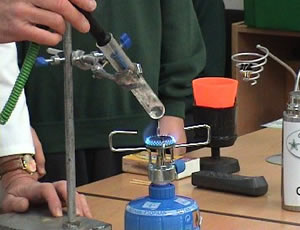 |
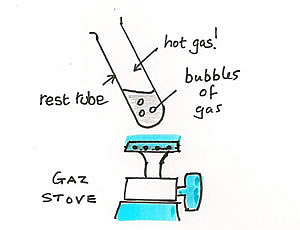 |
| A simple demonstration of a change of state from liquid to gas using gaz stove showing bubbles of steam. Steam is a colourless gas which condenses when its temperature drops below 100 degC. When the steam condenses in the air, eg after leaving the spout of a kettle, it forms a mist of very tiny droplets of water, This is really a hot fog similar in appearance to the cold fog we are familiar with on a winter morning. |
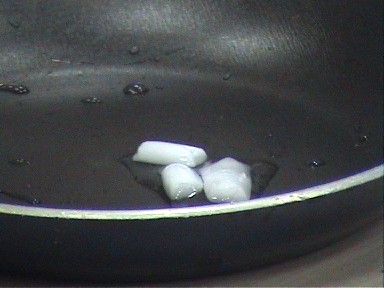 |
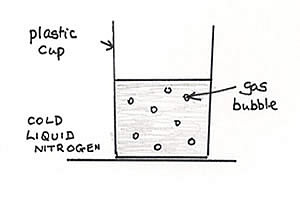 |
| Normal ice turns to liquid water when its temperature goes above 0 degC. We can call this 'water ice' because there are other types of ice! As we shall see, you can have ice that does not melt because it is not made of water. One common example is carbon dioxide ice which is faitrly easy to make and is called 'dry ice'. |
When liquid nitrogen is poured into a beaker it immediately starts to boil as shown here showing bubbles. The bubbles are made of pure nitrogen gas which rise to the top of the liquid and pass into the air to join the rest of the nitrogen gas which makes up 80% of our atmosphere. In our world there is no such thing as warm liquid nitrogen! |
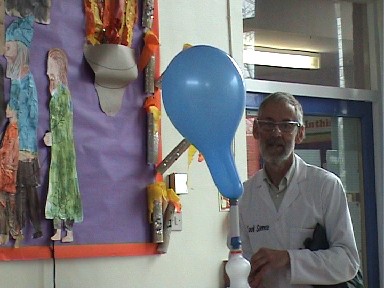 |
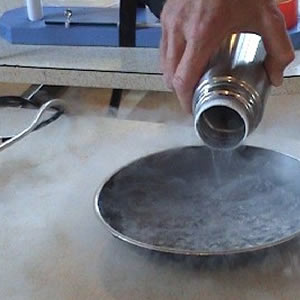 |
If some liquid nitrogen is poured into a plastic bottle and a balloon is attached as shown, the gas from the liquid nitrogen fills out the balloon. If enough liquid has been put into the bottle, the balloon will expand to bursting point much to the amusement of watching children and, often, their teachers and/or parents. Remember that the expansion ratio for the liquid to gas change is about 1 to 1000. The school display background looks like this picture was taken at Christmas!
video clip |
If you pour liquid nitrogen into a frying pan at room temperature, it immediately starts to bubble and it is not long before all the liquid has disappeared. Notice that the frying pan is around 200 degC hotter than the liquid so what you see here is very much like spilling some water on a cooker hotplate.
One consequence of this behaviour is that you need very expensive thermos flasks to store liquid nitrogen which stop almost all the heat energy which is trying to enter the flask from the air around it. |
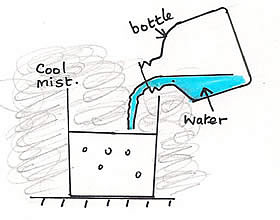 |
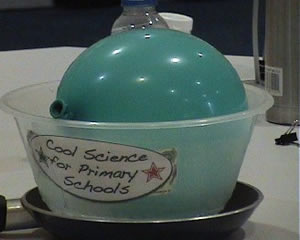 |
| When water is poured into liquid nitrogen mist pours out of the container. Children enjoy the effect of blowing over the container: their breath turns into mist or fog. What is happening here is that a constituent of air called water vapour (invisible) has condensed into those tiny droplets of water mentioned earlier. What I like about this LN induced fog is that it falls down from the beaker because cold air is denser than air at normal temperature. Of course the water turns into ice very quickly. You can make an ice cube in less than one minute! |
Balloons are very useful for demonstrating changes of state when you have access to whole bowlfuls of liquid nitrogen. Here a balloon is dunked in liquid nitrogen. The molecules batter the inside surface of a balloon at about 1000mph at normal temperature and this keeps the balloon 'inflated'. When the balloon is cooled the molecules slow down as they lose energy and the balloon shrinks. In the case of air the very low temperature of the liquid nitrogen will make the gases nitrogen and oxygen condense into a few teaspoons of liquid air (liquid oxygen and liquid nitrogen) |
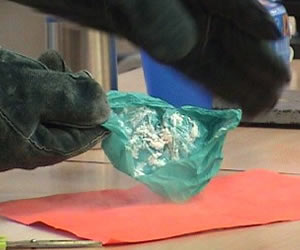 |
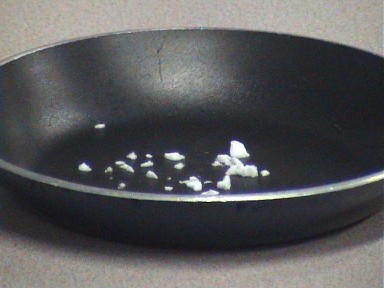 |
| If the dunked balloon is filed with carbon dioxide, the gas freezes into dry ice (carbon dioxide in solid form). The balloon can be cut open to show this. On the planet Mars, winter temperatures cause some of the air (mostly carbon dioxide but very thin) to form into dry ice. |
If some dry ice is sprinkled into a frying pan as shown here, it shows up very clearly. Careful observation shows liitle bits of ice 'disappearing' as they turn back into gas. This gas may give them a little push before they disappear .. they seem 'alive' almost. Of course there is no sign of liquid water. |
 |
 |
| A fascinating demonstration of the subliming of dry ice (turning straight into gas as it warms up) is to put a small quantity of dry ice into a syringe as shown here. Alternatively dry ice can be put into a balloon using a filter funnel. If the neck of the balloon is then tied, the balloon will expand as the ice sublimes. |
Yet another fun demonstration of this is to put some dry ice into a tub and firmly replace the lid and wait. After a couple of minutes the top of the tub will burst off with a bang much to the delight and hopefully surprise of the audience. |
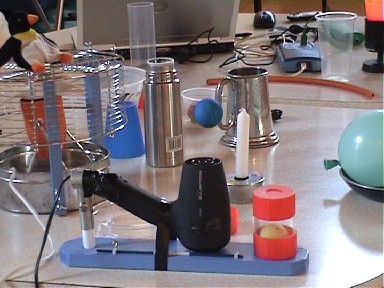 |
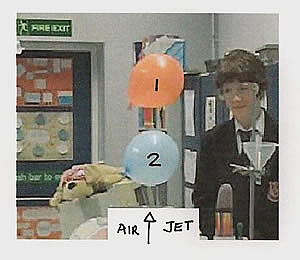 |
| The next three pictures show some fun things you can do with gases but have nothing to do with the topic of changing state. The first is to balance a table tennis ball on a jet of air from a hair drier. Once hovering the hair drier can be moved or tilted without losing the balancing ball! |
The picture above going back to 2007 shows one of my favourite demonstrations. You use the hair drier as in the previous picture but this time two balloons are used. One contains air (1) and one (heavier) contains carbon dioxide. In the background you can just see George the Safety Dog with his safety glasses in place! |
 |
.jpg) |
| This invention sometimes called the whizzer is a nice demonstration of the invisible air causing a visible effect. There are two other versions, one using an inflated balloon, which do not use liquid nitrogen! |
Another favourite invention which arrived in 2006 was Ermintrude the Rocket Cow shown here. As the video clip shows, Ermintrude is launched with the aid of liquid nitrogen fuel building up pressure and blowing the stopper out! Cow from Tesco Stores, Long Eaton! |
Sound Vibrations and Light: demonstrations to intrigue children of any age |
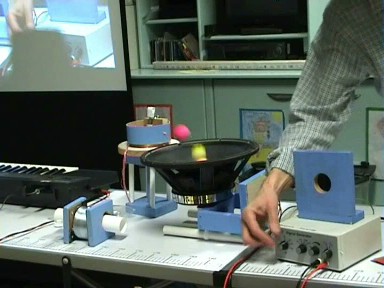 |
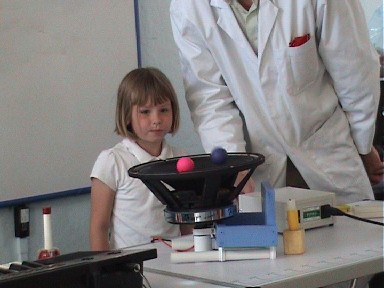 |
| The loudspeaker shown here arrived from a German company and was rather larger than I had expected but it has proved invaluable over the years to show vibrations cause sound waves. The signal generator was a gift from my old school, Trent College, in recompense for help I gave post retirement. Note also the slinky in the forground. video clip |
Here an infant school volunteer (KS1) helps with the bouncing ball demo. The signal generator allows the frequency and strength of the vibrations to be altered at will. It is surprising how excited children of this age get as the pitch or amplitude of the vibrations is increased. There is a resonance point where they bounce most and sometimes bounce off the loudspeaker entirely! |
 |
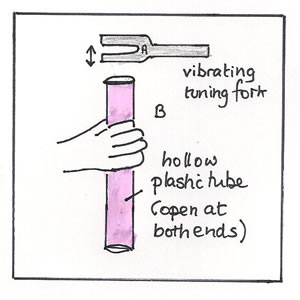 |
| This colourful set of 8 musical bells covering the complete musical scale of C major is a favourite of the younger pupils. They 'ding' when tapped as shown here. Interestingly I have found many chilren from Y1 have difficulty recognising pitch but are ok on this by Y2. With KS1 we usually sing Twinkle Twinkle Little Star accompanied by me on 'the bells'! |
This is such a simple demonstration but it really impresses audiences of any age. The plastic tube is taken from a 'boomwhacker' set and matches the A note given by the tuning fork. As the vibrating fork is passed over the top of the tube, sound volume rises sharply as the air inside the tube is set into vibration mode.. Sound waves inside the tube actually reflect back and forth inside the tube in a 'standing wave'. |
 |
 |
| Another popular demonstration which works well for a large audience eg in a school hall. A small plane mirror is attached by velcro to the speaker cone. As the speaker starts to vibrate the mirror also vibrates and these small vibrations are dramatised (amplified) by the reflected laser beam. I usually set this up so a dancing red spot appears on the hall ceiling in tune with the changing sound. Care should be taken to avoid the beam reaching any pupils though these small Class 2 lasers are considered safe to use because of our 'blinking reflex'. |
Here a microphone is connected to a Cathode Ray Oscilloscope, another gift from Trent College for servicse rendered. When the vibrating tuning fork is held close to the mike, a very simple wave pattern appears on the screen. Each peak on the pattern is only about 1/400 th second from the next! Clever stuff and why the CRO is an expensive bit of kit!
video clip 1 video clip 2 |
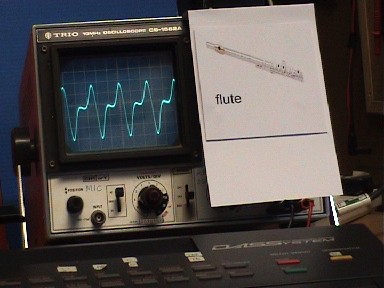 |
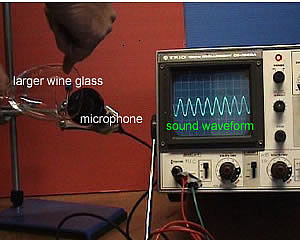 |
| Each musical instrument makes a distinctive sound so that we can distinguish betwee different instruments when they are playing the same note. Here we see the waveform of the sound made by a flute .. a clear and repeated pattern but not a pure 'sine wave' as shown in the previous image. harp waveform and piano waveform |
A good quality wine glass can be made to 'sing' ie give out a prolonged sound by rubbing a wet finger round its rim. If at the same time a microphone is placed near the vibrating glass, a surprisingly pure waveform shows a pure sound is being given. video clip |
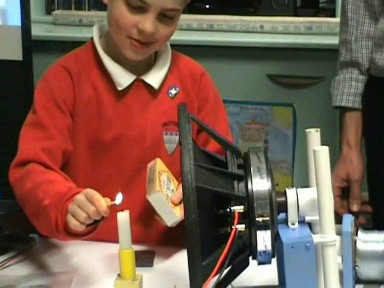 |
 |
| The large loudspeaker can easily be used to show sound wave vibrations passing through the air as seen above. When the match is lit and the speaker is turned ON, the candle flame is seen to flicker in tune with the sound. A low frequency high volume sound has to be used. A good blackout helps. video clip |
Moving with the times, we see here a demonstration of sound being carried on a laser beam. The musical signal from a radio is fed into the laser box. If the beam is then adjusted to fall on to the 'magic eye' of the receiver, you can hear the music. A piece of card or coloured plastic film can then be used to stop the sound. Note that if red plastic is used, the beam easily passes through. |
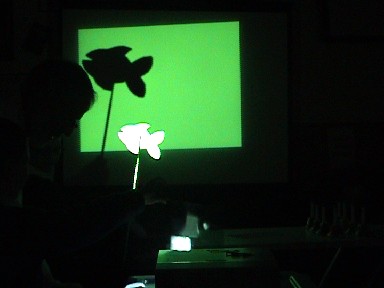 |
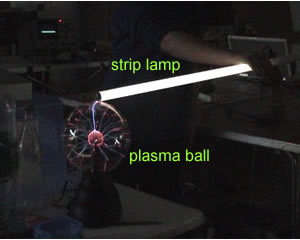 |
| For younger children, shadow formation is an important topic. Here a piece of green plastic film has been placed in the beam from a video projector to give a 'green screen', The cardboard fish shape then gives a sharp black shadow on the screen. I often use an array of shadow animals and an island backdrop to add a fun element to this topic. |
This is a very popular experiment. A strip lamp is brought carefully up to but NOT touching a live plasma ball. It is seen to light up showing the large voltage present on the surface of the plasma ball. Then its fun to try the effects of (1) touching the plasma ball and (2) sliding a hand down the lamp. |
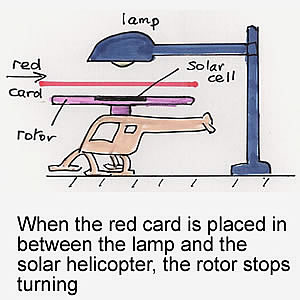 |
 |
| Light carries energy and solar toys like this helicopter use solar cells to convert it to electricity. Here the light energises a rotor motor. Children then try different coloured film and card as shown to try to stop the rotor turning. |
Here the blue plastic only lets through blue light but the helicopter keeps turning. See here for a short video clip |
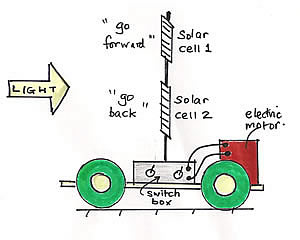 |
.jpg) |
| This solar cell powered buggy is a good teste of problem solving for older classes. The buggy has been fitted with two solar cells wired up through a switch to A: work alone, B: together or C: in opposition. The sketch above shows option C |
What some pupils can figure out is that in Option C, they can use the plastic square shown above to block ONE of the solar cells and immediately the buggy moves one way or the other! |
Forces & Magnets
|
 |
 |
| Pupils investigate the effect of increasing weight and using different types of spring. Simple but quite popular. It formed part of a series of demos showing the balance of forces needed for the old SATS in Science. |
This started off my interest in G Scale railway! I now sometimes use an 8ft layout to demonstrate some 'railway science'. What this demo shows really well is the effect of extra weight on traction. I bring more than one loco. |
 |
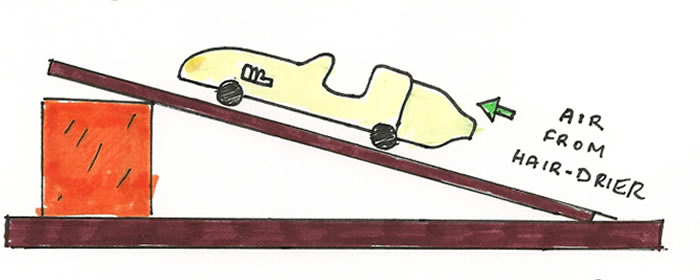 |
| A vary large helium balloon can be used here and different weights added to the coracle. A good example of opposing forces. Occasionally I put liquid nitrogen in the coracle so that it only lifts off when some of the liquid has boiled of. Very dramatic!! |
Again a simple demo of opposing forces and seems to engage the children perhaps because of the various toy vehicles used. The ramp is also good for showing friction under a baked bean tin in upright versus rolling positions. |
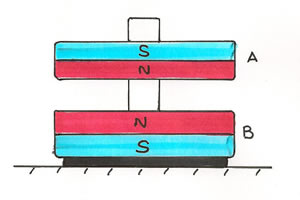 |
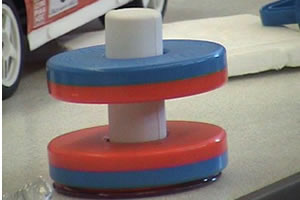 |
| The floating magnet trick showing repelling magnets |
Floating magnets demonstration. |
 |
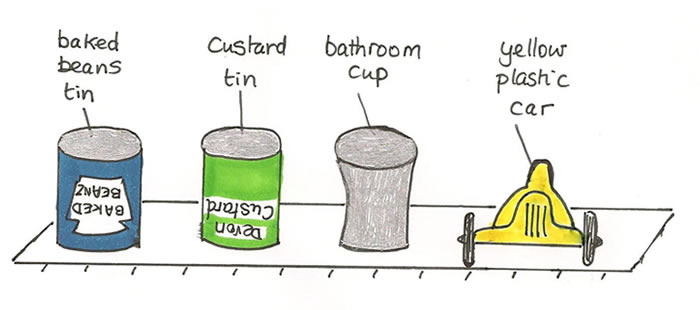 |
| Using avariety of materials as shown here with a magnet leads to some useful discussions about recycling etc |
The bathroom cup shows NO response when a magnet is used. It is made of aluminium so it doesn't rust , hence it is non-magnetic. |
.jpg)
|
.jpg) |
| Our Van De Graff generator is a fun way of showing the elctrical force (static). Like charges repel so strands of charged hair spread out as much as possible. The voltage here is at least 20 000 volts but quite safe because the current flow involved is microamps. |
The topic of static electricity fits equally well under electricity (as shown here) or forces. In the background you can see two demonstration circuit boards I made for the electricity topic. The backboard proved a useful design for my constellation boards built in summer 2015. |
| |
|
| |
|















.jpg)















.jpg)








.jpg)
.jpg)